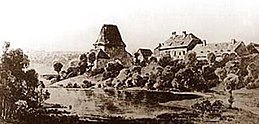Bejšovec from Bejšov
The Bejšovec from Bejšov also Byšovec from Byšov (Czech Býšovcové z Býšova ) were a family of rural nobles who settled mainly in southern Bohemia .
history
The strong fragmentation into secondary lines and the impoverishment during the Thirty Years' War do not allow a clearly delimited genealogical examination. The Bejšovec from Bejšov left their mark especially in southern Bohemia in the vicinity of the Bejšov castle, but there are also villages and towns in western Bohemia and Moravia.
The origin is assumed to be in the Polish area due to the horseshoe symbol in the coat of arms and a subsidiary line Beyschowetz in Austria, which can be traced back to the Polish Bychowiecz . The Slavic name Bejšovec has not yet been translated by any modern Slavic language (Czech / Polish). The meaning or the reference to a locality (Bejšov-ec = "that of Bejšov") is probably hidden in Old Slavonic.
Byšov Castle
As the first representatives, the brothers Arnošt and Kuník are mentioned for the first time in 1395 as patrons of the church in Křtěnov. This village had to give way to the construction of the Temelín power station , but the church and cemetery are still standing next to the nuclear power station.
The headquarters of the Bejšovec from Bejšov was a stone residential tower from the 15th century. This is located near Temelín , five kilometers southwest of the town of Týn nad Vltavou . In Byšov there is a tower and the remains of former manor buildings.
The facility is surrounded in a semicircle by three ponds, which should make it difficult to storm in the event of war. The castle was integrated into an estate with which it formed an economic unit.
In 1615 Jan Bejšovec von Bejšov sold the castle to the Malovec von Malovic family due to financial difficulties : Jan Bejšovec von Bejšov the Younger, son of Mikulaš, lived with them in 1589; but in 1615 he owned nothing in Bejšov and lived in the village of Dasné, which is later often referred to as "Bejšov's farm". The move to Dasné happened because he and his uncles had sold their shares to the Lords of Malovec for their rule Hluboka and Dřiteňsky, after which the old castle was turned into a bulk floor.
After the Thirty Years' War and the re-Catholicization, the property came to the Schwarzenbergs . He stayed there until 1930, when the estate was leased to the landlord Wladimir Sailer after the Schwarzenbergs had been expropriated. Judging by its structural condition, the Bejšov manor was still an agricultural enterprise during the socialist times.
The castle was then owned by the Temelin nuclear power plant and stood empty for a long time. The fabric of the buildings had suffered greatly from the effects of the weather. Only the castle tower has remained in better condition due to the massive medieval construction.
In 2005, construction work began to build a rapeseed oil factory, during which the entire front part of the estate was demolished. After the reconstruction of the remaining structure, the offices of the factory and an information center in the castle tower are to be built in the former manor house and the stables.
Bejšov farm
The ruins of the Meier farm Bejšov are about seven kilometers west of Jistebnice between the villages Pazderna and Vesec. The farm was first mentioned in the 16th century when it was acquired by Matěj Byšovec from Byšov. The forest in question is also called Bejšov today.
people
- Voldřich / Ulrich Bejšovec, 1594 lieutenant in the Rosenberg troops
Name versions / spellings
Bejšovec from Bejšov or in Czech Bejšovec z Bejšova (also Byšovec z Byšova ) is the common form in Czech. Today, however, the only name used in the Czech Republic, Germany and the USA is Bejšovec. Byssowec is a Latinized version in old documents. Beyschowetz / Beischowetz are typical Germanizations in Germany and Austria. Bychowiec is the Polish spelling.
coat of arms
| Coat of arms 1: Bejšovec from Bejšov | |
|
Blazon : "The coat of arms has a golden horseshoe on a blue shield and also as a helmet ornament."
The unique use of horseshoes in Polish heraldry indicates an origin from the Polish area. |
|
| Coat of arms 2: Bejšovec from Bejšov | |
| Blazon : "The coat of arms bears the white neck of a vulture on a red shield, two horns white and red on the helmet, with a yellow bullet in between." | |
Which coat of arms (variant 1 or 2) can be assigned to which line of the Bejšovec of Bejšov has not yet been clarified.
| Coat of arms 3: Beyschowetz "Mogiła" | |
|
Coats of arms of the Beyschowetz, which are based in Austria today and descend from the Polish Bychowiec. In Poland, however, coats of arms are mostly used by many noble families as group coats of arms. |
|
Individual evidence
- ↑ a b August Sedláček : Hrady, Zamky a Tvrze . Prague 1934
- ↑ Václav Březan : Životy poslednich Rožmberku . Svoboda Praha 1985





